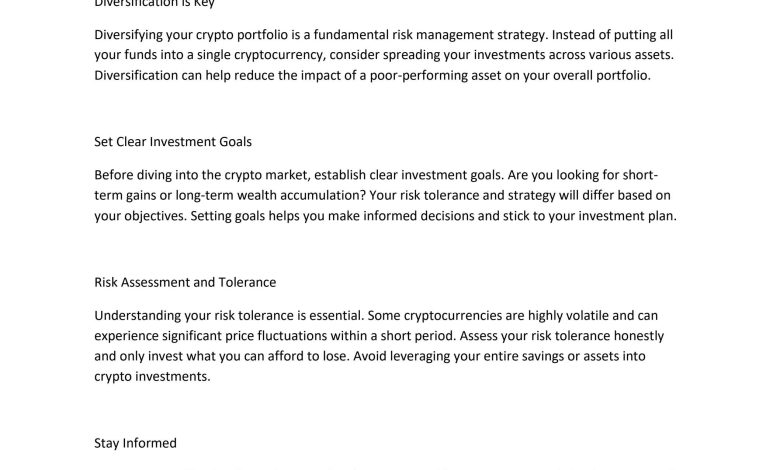The Importance of Risk Management in Crypto Investing

- Understanding the risks associated with crypto investing
- Implementing effective risk management strategies in your crypto portfolio
- The role of risk management in minimizing losses and maximizing gains in crypto investing
- Common risks faced by crypto investors and how to mitigate them
- Why risk management is crucial for long-term success in the volatile world of cryptocurrencies
- Balancing risk and reward: the key to successful crypto investing
Understanding the risks associated with crypto investing
When it comes to crypto investing, it is crucial to understand the risks involved in this volatile market. Cryptocurrencies are known for their price fluctuations, which can lead to significant gains or losses in a short period of time. It is essential for investors to be aware of these risks and to have a risk management strategy in place to protect their investments.
One of the main risks associated with crypto investing is market volatility. Prices of cryptocurrencies can be highly unpredictable, with sharp fluctuations occurring within minutes. This can result in substantial losses for investors who are not prepared for such price swings. It is important to have a clear understanding of the market dynamics and to be prepared for sudden changes in crypto prices.
Another risk to consider is the lack of regulation in the crypto market. Unlike traditional financial markets, the crypto market is not regulated by any central authority. This lack of oversight can make cryptocurrencies vulnerable to fraud, hacking, and other illegal activities. Investors should be cautious and conduct thorough research before investing in any crypto assets.
Furthermore, the security of crypto investments is also a significant concern. Cryptocurrencies are stored in digital wallets, which can be vulnerable to cyber attacks and hacking attempts. Investors should take precautions to secure their crypto assets, such as using strong passwords, enabling two-factor authentication, and storing cryptocurrencies in secure hardware wallets.
In conclusion, while crypto investing can be highly profitable, it is essential to understand and manage the risks associated with this market. By having a solid risk management strategy in place, investors can protect their investments and navigate the volatile world of cryptocurrencies more effectively.
Implementing effective risk management strategies in your crypto portfolio
Implementing effective risk management strategies in your crypto portfolio is crucial to protect your investments and maximize returns. By carefully assessing and mitigating risks, you can minimize potential losses and increase the chances of success in the volatile cryptocurrency market.
One key strategy is to diversify your portfolio across different cryptocurrencies and assets. This helps spread risk and reduce the impact of any single investment performing poorly. Additionally, setting stop-loss orders can help limit losses by automatically selling an asset if its price falls below a certain threshold.
Another important aspect of risk management is conducting thorough research before making any investment decisions. Stay informed about the latest market trends, news, and regulatory developments that could affect the value of your crypto assets.
It’s also essential to establish clear investment goals and risk tolerance levels to guide your decision-making process. By knowing how much risk you are willing to take on, you can avoid making impulsive trades based on emotions.
Regularly reviewing and adjusting your risk management strategies is key to adapting to the ever-changing crypto market. Be prepared to make adjustments as needed to ensure your portfolio remains balanced and resilient in the face of market fluctuations.
The role of risk management in minimizing losses and maximizing gains in crypto investing
Risk management plays a crucial role in the world of crypto investing, as it helps investors minimize potential losses and maximize gains. By implementing effective risk management strategies, investors can protect their investments from market volatility and unforeseen events.
One key aspect of risk management in crypto investing is diversification. By spreading investments across different cryptocurrencies, investors can reduce the impact of a single asset’s poor performance on their overall portfolio. Diversification helps to mitigate risk and increase the chances of achieving positive returns.
Setting stop-loss orders is another important risk management technique in crypto investing. By establishing predetermined price levels at which to sell an asset, investors can limit their losses in case the market moves against them. Stop-loss orders help investors maintain discipline and avoid emotional decision-making.
Furthermore, conducting thorough research and analysis before making investment decisions is essential for effective risk management. By staying informed about market trends, regulatory developments, and technological advancements, investors can make more informed choices and reduce the likelihood of making costly mistakes.
In conclusion, risk management is a critical component of successful crypto investing. By diversifying investments, setting stop-loss orders, and staying informed, investors can minimize losses and maximize gains in the volatile world of cryptocurrencies.
Common risks faced by crypto investors and how to mitigate them
Investing in cryptocurrency comes with its own set of risks that investors need to be aware of in order to protect their investments. Here are some common risks faced by crypto investors and strategies to mitigate them:
- Volatility: One of the biggest risks in the crypto market is the high level of volatility. Prices can fluctuate dramatically in a short period of time, leading to potential losses. To mitigate this risk, investors should diversify their portfolio across different cryptocurrencies and asset classes.
- Security: Security breaches and hacks are prevalent in the crypto space, leading to the loss of funds. To protect against this risk, investors should use secure wallets, enable two-factor authentication, and avoid keeping large amounts of cryptocurrency on exchanges.
- Regulatory: Regulatory uncertainty is another risk that crypto investors face. Changes in regulations can impact the value of cryptocurrencies and the ability to trade them. To mitigate this risk, investors should stay informed about regulatory developments and comply with local laws.
- Liquidity: Cryptocurrency markets can be illiquid, meaning that it may be difficult to buy or sell assets at desired prices. To mitigate this risk, investors should trade on reputable exchanges with high trading volumes and avoid investing in low-cap coins.
- Market manipulation: The crypto market is susceptible to manipulation due to its decentralized nature and lack of regulation. To protect against this risk, investors should conduct thorough research before investing, avoid pump-and-dump schemes, and be cautious of social media influencers promoting certain coins.
By being aware of these common risks and implementing strategies to mitigate them, crypto investors can better protect their investments and navigate the volatile market with more confidence.
Why risk management is crucial for long-term success in the volatile world of cryptocurrencies
Effective risk management is essential for ensuring long-term success in the unpredictable world of cryptocurrencies. With the volatile nature of the crypto market, investors face a myriad of risks that can lead to significant losses if not properly managed. By implementing a robust risk management strategy, investors can protect their investments and increase their chances of achieving sustainable growth over time.
One of the key reasons why risk management is crucial in crypto investing is the high level of uncertainty and price fluctuations that characterize the cryptocurrency market. Prices of digital assets can experience rapid and drastic changes within a short period, making it challenging to predict market movements accurately. Without a solid risk management plan in place, investors are exposed to the risk of losing a substantial portion of their capital due to sudden price drops or market crashes.
Furthermore, effective risk management can help investors mitigate the impact of external factors such as regulatory changes, security breaches, and market manipulation. By diversifying their crypto portfolio, setting stop-loss orders, and conducting thorough research before making investment decisions, investors can minimize their exposure to various risks and protect their assets from unforeseen events that could negatively affect their investments.
In conclusion, the crypto market offers significant opportunities for investors to generate substantial returns, but it also comes with inherent risks that must be carefully managed. By prioritizing risk management and implementing sound strategies to protect their investments, investors can navigate the volatile cryptocurrency landscape with confidence and increase their chances of achieving long-term success in this rapidly evolving industry.
Balancing risk and reward: the key to successful crypto investing
When it comes to crypto investing, finding the right balance between risk and reward is crucial for success. It is essential to understand that the cryptocurrency market is highly volatile, and prices can fluctuate dramatically in a short period. Therefore, it is important to manage your risk effectively to protect your investment.
One way to balance risk and reward is to diversify your portfolio. By spreading your investment across different cryptocurrencies, you can reduce the impact of a potential price crash on any single asset. This strategy can help you minimize your losses while still capitalizing on profitable opportunities.
Another key to successful crypto investing is to conduct thorough research before making any investment decisions. By analyzing market trends, project fundamentals, and technical indicators, you can make more informed choices that align with your risk tolerance and investment goals.



